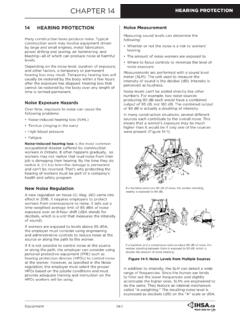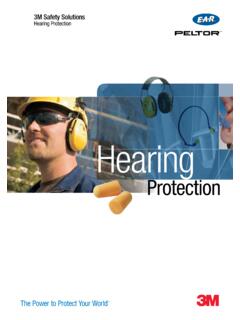Transcription of NRR or IPIL for Gunshot Noise Hearing Protection Selection?
1 NRR or IPIL for Gunshot Noise Hearing Protection Selection? Scott LakeDefendEar: Manager of Engineering and Technical SalesJuly 10, 2013 Westone Laboratories, Inc. 2235 Executive Circle, Colorado Springs , CO 80906 the United States, Hearing Protection is sold with a Noise reduction Rating (NRR) that is required by the Environmental Protection Agencyi. The purpose of the NRR is to inform consumers about the potential to reduce hazardous sounds to a level which is safe for the ear of the person using the Protection . The input data to calculate the NRR requires that Hearing Protection is tested via a method designed to assess the attenuation in the presence of continuous Noise .
2 Subjects are tested with their ears open and with the protectors covering the ears or inserted into the ear canal. When sounds of different frequencies are presented, the subject must respond to the lowest level sound to determine the Hearing thresholds for each frequency. Because the maximum attenuation possible by tightly sealing a person s ears is only about 50 to 60 decibels (the difference between a really quiet room and a conversation in a quiet room), the performance of the protector is measured in the linear acoustic regime. That is, sound is attenuated by the protector and the attenuation doesn t change appreciably for quiet, moderate or even loud sounds.
3 For most of the noises that one might experience in the workplace or working with tools around the home or at activities like sporting events and concerts, the protectors will provide the same amount of attenuation. However, when one experiences exposures to extremely loud sounds like gunshots, fireworks and even some pneumatic tools ( nail guns or powder-actuated tools), the attenuation provided by the Hearing protector is no longer constant. Technically speaking, this test method does not use any kind of sound that is similar to what is experienced during Gunshot and other loud, impulsive Noise events.
4 The test to determine the input data to calculate NRR uses pulsed, 1/3 octave band-limited noises for test signalsii presented to test subjects without Hearing Protection in place and with Hearing Protection in place. The task for the subject is to indicate when they hear the test signals. Without Hearing Protection in place, the test signals are very quiet. With Hearing Protection in place the test signals can be the same level and up to around 50 or 60 dB higher than the levels present without Hearing Protection in place. However, even with the potential of 50 to 60 dB increased level, these levels do not come close to what happens during a Gunshot , which has peak levels of roughly 115 dB and higher.
5 The attenuation of a typical earplug, ear muff or canal cap will not be the same for low-level Noise as for high-level impulse interaction with the protector. Response will vary from nearly linear to highly non-linear response depending on the type of protectoriii. Thus, the attenuation reported as the NRR and quantified with the method currently required by the EPA will not describe how well the protector performs to attenuate high-level impulsive sounds such as Gunshot 2009, the EPA proposed to change the way that Hearing Protection is measured and reported to the consumeriv.
6 For Hearing protectors designed to provide little attenuation at low levels and higher attenuation at high-levels, the EPA developed an IMPULSE rating to describe the change in the peak impulse level over a range of 130 to 170 decibels. Recreational shooters and law enforcement personnel are exposed to impulses from their weapons at the higher end of the range,150 to 170 dBv. The proposed ruling has not yet goneinto effect, so there is still no requirement to label Hearing protectors with an IMPULSE , is Hearing Protection performance testing and rating at high levels important or not?
7 Because attenuation tends to increase as the impulse level increases, the constant value derived from the NRR measurement method will likely understate the amount of Protection that one may receive when wearing the Protection of a new Test Method: ANSI the earliest studies of Hearing loss due to impulse Noise , experts have been seekinga method to describe the performance of Hearing Protection for high-level exposures. In the early 1990s the French German Research Institute in Saint Louis, France (ISL) developed an acoustic test fixture that allowed Hearing Protection to be tested and permitted estimation of the exposure levels at the eardrum.
8 The American National Standards Institute (ANSI) devel-oped a new standard for use with an acoustic test fixture like the one ISL developed. The new ANSI standard was approved and published in 2010 and has been used in several stud-ies conducted by the National Institute for Occupational Safety and Health to provide support for the EPA s proposed revision of the Hearing protector labeling regulation. To quantify the attenuation of this non-linear behavior, ANSI uses three levels of impulsive noises, with peak values at nominally 132, 150 and 168 dB SPL, that are represen-tative of peak exposures commonly present at the ear for different types of firearms.
9 Three levels are used instead of a single level, because the attenuation properties are non-linear, meaning that attenuation will be different, dependent on the level of the peak Noise expo-sure. The amount of attenuation that is present for these different exposure levels is referred to as the Impulsive Peak Insertion Loss, abbreviated as IPIL. Insertion Loss is the terminology given to a certain type of attenuation that is characterized by measuring Noise levels with and without some type of barrier in place with the difference of the Noise levels with and without the barrier forming the basis for the Insertion Loss metric.
10 IPILvi is very similar to the EPA s pro-posed IMPULSE IPIL ResultsWestone has tested both their DefendEar Hunter Passive product, as well as their DefendEar Digital product line for IPIL, according to ANSI , at Michael & Associates, an inde-pendent NVLAP accredited testing of IPIL or NRR for Gunshot Noise Hearing Protection Estimation: Which?The EPA has not issued a final regulation that requires provision of an IMPULSE NRR for Hearing protector performance in impulse Noise . Regardless of whether EPA finalizes the proposed regulation, the Hearing protector consumer should understand the distinctions between IPIL and NRR and how IPIL may be applied to estimate one s exposure.









